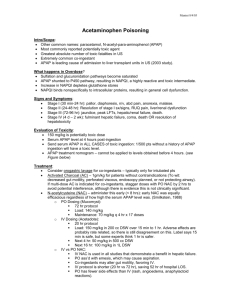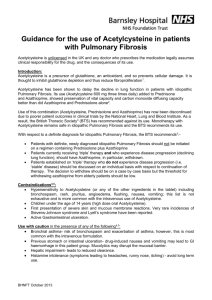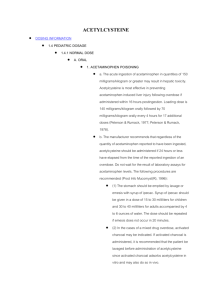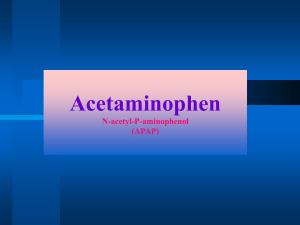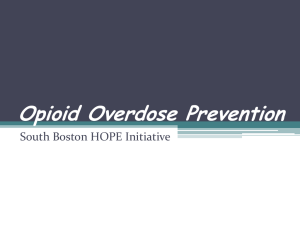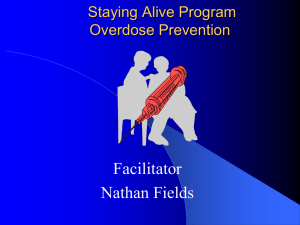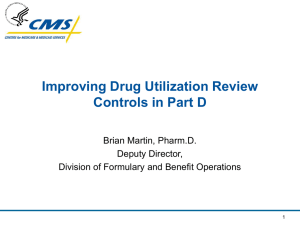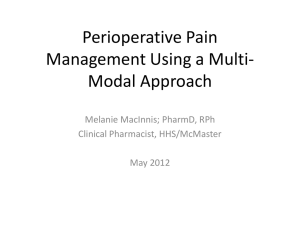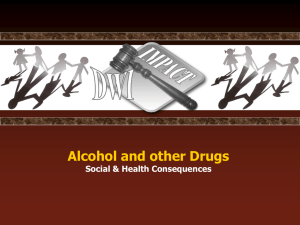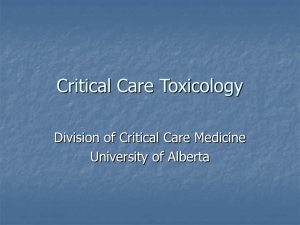Mucomyst (Acetylcysteine, Acedote)
advertisement
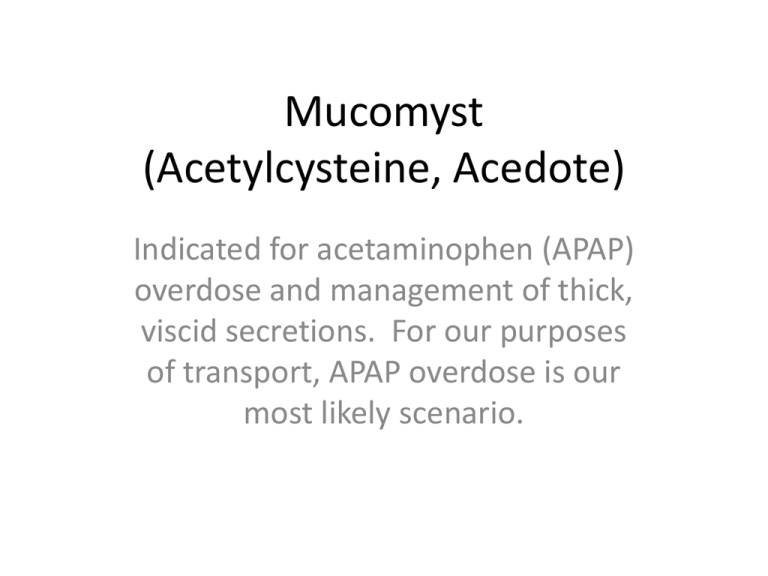
Mucomyst (Acetylcysteine, Acedote) Indicated for acetaminophen (APAP) overdose and management of thick, viscid secretions. For our purposes of transport, APAP overdose is our most likely scenario. Acetylcysteine classification • Therapeutic classifications: – Antidote for Tylenol (APAP) overdose. Acts as a binding agent for metabolized APAP. – Mucolytic. Oral versus IV • Oral administration is much cheaper. • Oral administration is the preferred route for therapy unless contraindications exist (e.g aspiration, persistent vomiting). • Both oral and intravenous are well tolerated. Nausea and vomiting are common with oral administration. Intravenous use has been associated with the development of anaphylactoid reactions. • Typical therapies are the 72 hour oral or 20 hour IV regimen. Oral versus IV • Intravenous indications: – Refractory emesis despite antiemetics. – Concomitant ingestion that requires continuous gastrointestinal decontamination that would interfere with oral administration. – Gastrointestinal bleeding/obstruction or caustic ingestion. – Altered mental status/high aspiration risk. – Patient refusal to take orally, NG tube not an option. – Neonatal APAP toxicity from maternal overdose. – In utero exposure from maternal OD (i.e., pregnant patient). Interactions and contraindications • Activated charcoal may absorb orally administered Acetylcysteine and decrease therapeutic effect. Interaction Rating = Moderate • Nitroglycerin can dilate blood vessels and increase blood flow. Taking Acetylcysteine seems to increase the effects of nitroglycerin. This could cause increased chance of side effects including headache, dizziness, and lightheadedness. Interaction Rating = Major. Also included is Viagra, Cialis and Levitra. Adverse effects / side effects • For both oral and IV administration – Drowsiness, vasodilation (hypotension), bronchospasm, nausea, vomiting, rash, pruritis (itching). • For IV only administration – Anaphylaxis, angioedema, chills and fever. • Most reactions will occur during the loading dose. • Asthmatics are more likely than non-asthmatics to experience side effects. Pregnancy category B • Pregnancy Category B • It is not known whether this drug is excreted in human milk. Because many drugs are excreted in human milk, caution should be exercised when Acetylcysteine is administered to a nursing woman. Acetylcysteine indications as a mucolytic • Acetylcysteine is indicated for abnormal, viscid, or thick mucous secretions in such conditions as: – Chronic bronchopulmonary disease – Acute bronchopulmonary disease – Pulmonary complications of cystic fibrosis – Tracheostomy care – Atelectasis due to mucous obstruction Mucolytic doseage • Typically given as inhalation nebulizer. – Inform patient of “rotten egg” smell prior to administration. – 3 to 5 ml of 20% solution or 6 to 10 ml of 10% solution 3-4 times daily until secretions decreased. • Oral administration. Take medication as ordered. Acetylcysteine as mucolytic • WARNINGS • After proper administration of Acetylcysteine, an increased volume of liquified bronchial secretions may occur. When cough is inadequate, the airway must be maintained open by mechanical suction if necessary. Where there is a mechanical block due to foreign body or local accumulation, the airway should be cleared by endotracheal aspiration, with or without bronchoscopy. Asthmatics under treatment with Acetylcysteine should be watched carefully. Most patients with bronchospasm are quickly relieved by the use of a bronchodilator given by nebulization. If bronchospasm progresses, the medication should be discontinued immediately. APAP overdose pathophysiology • Acetaminophen is a common pharmaceutical that is available to patients as a solitary agent and in combination with many other drugs. Patients may present with intentional, accidental, acute, and chronic ingestions • Regardless of formulation, the time from ingestion to peak acetaminophen level is approximately 4 hours. Liquid formulations peak somewhat quicker, and even extended-release preparations are almost completely absorbed by 4 hours. APAP overdose pathophysiology • Acetaminophen is metabolized primarily through the liver. The oxidative step is responsible for production of N-acetyl-p-benzoquinoneimine (NAPQI). In therapeutic doses of acetaminophen, NAPQI is detoxified via hepatic clearance. With supratherapeutic ingestions of acetaminophen, the binding protein (glutathione) becomes depleted, and NAPQI binds to hepatocellular proteins, causing liver toxicity. • Acetylcysteine serves as a binding agent substitute. In critically ill patients Acetylcysteine may stop multi-organ failure and improve cerebral edema. Acute ingestion of APAP • Acute ingestions are single ingestions occurring within a 4-hour period. When this history is clear, the appropriate treatment protocol is straightforward. Serious sequelae are avoidable as long as therapy is begun within 8 hours of ingestion. A 4-hour acetaminophen level is obtained. • Acetylcysteine therapy is initiated if the acetaminophen concentration is on or above the nomogram treatment line, the AST is elevated, or the acetaminophen concentration is greater than 10 mcg/mL and the time of a suspected toxic ingestion is unknown. Chronic ingestion of APAP • By definition, chronic ingestions are multiple, occurring over more than 4 hours. • Risk factors may place patients at higher risk for hepatotoxicity. These include malnutrition, chronic alcohol use, in children, an associated febrile illness, and use of drugs that induce the CYP2E1 system (Most drugs undergo deactivation and/or metabolism by CYP2E1, either directly or by facilitated excretion from the body). Acetylcysteine As An Antidote for APAP Overdose • There are no contraindications to oral administration of Acetylcysteine in the treatment of acetaminophen overdose. • Oral administration of Acetylcysteine, especially in the large doses needed to treat acetaminophen overdose, may result in nausea, vomiting and other gastrointestinal symptoms. Rash with or without mild fever has been observed rarely. Acetylcysteine oral dosing for APAP overdose • Adult and children, 140 mg/kg loading dose followed by 70 mg/kg every 4 hours x 17 doses. • Oral Acetylcysteine tastes horrible and may effect patient compliance. Acetylcysteine (for APAP overdose) IV administration • Watch for breathing complications. Asthmatic patients are more likely than nonasthmatic patients to experience side effects. • The most significant may result in flushing, urticaria, pruritus, bronchospasm, angioedema, hypotension, and tachycardia. • Although approximately 1% of these reactions are severe, the majority are mild. They should be treated symptomatically, and the infusion should be held. Medical direction should be contacted. Acetylcysteine (for APAP overdose) IV therapy for adult and children • Loading dose: 150mg/kg in 200ml D5W over 1 hour. (200cc per hour) • 1st maintenance dose: 50mg/kg in 500ml D5W over 4 hours. (125cc per hour). • 2nd maintenance dose: 100mg/kg in 1000ml D5W over 16 hours. (65cc per hour). • Dosages typically are calculated the same for pediatrics versus adults. • Note: These are typical doses. Physician orders may change. Supportive APAP overdose treatment Maintain fluid and electrolyte balance based on clinical evaluation of state of hydration and serum electrolytes. • Treat as necessary for hypoglycemia. • Administer vitamin K1 if prothrombin time ratio exceeds 1.5 or fresh frozen plasma if the prothrombin time ratio exceeds 3.0. • Diuretics and forced diuresis should be avoided.
